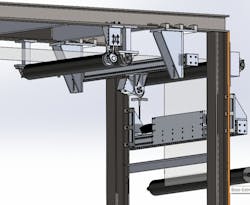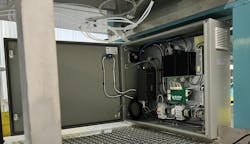Widely used in the production of medical supplies, pressure-sensitive adhesives (PSAs) are non-reactive adhesives that form a bond when pressure is applied to adhere the adhesive to a surface. In the medical field, PSAs are most often used for wound care or surgical repair procedures, therefore the quality of the material is paramount.
A PSA manufacturer for medical applications was experiencing yield losses due to wrinkle defects on its web-based manufacturing line used to produce the gauze-like, non-woven layer of the PSA product. These non-woven PSAs are fabricated on PET lightweight plastic and paper backing materials measuring about 28-in. wide by 0.001–0.003-in. thick. After adhesive coating of the backing material, a >0.001-in. to 0.003-in. thick, white, non-woven material is laminated to the backing at up to 180 feet per minute (fpm).
During the lamination process, the non-woven material can periodically develop wrinkles, which render the product unusable. The wrinkle defects formed during fabrication can be very difficult to see with the human eye because the gauze-like, non-woven material is very thin (<0.001-in.) and sheer. When these wrinkle defects are not detected and remedied, they can continue for hundreds of feet, resulting in the loss of raw materials, labor and overhead costs applied to the job.
Even more critical, if the wrinkles are not detected and removed prior to shipment, customers reject the product or, worse, the customer and the medical facility end user could suffer reputational and brand damage.
Unable to identify a commercially available machine vision system for this application, the manufacturer reached out to system integrator Vision Optronix to design a vision system that could detect, localize and report on wrinkle defects during fabrication. The goal of this new vision system would be to alert web coater operators to remedy the wrinkles immediately, in addition to automatically marking the location of the wrinkle defects, while avoiding the detection of any acceptable anomalies.
A wrinkle defect file would be created and stored along with defect images. This defect file would be used for later review by engineers and slitting operators who could then remove the wrinkle defects as marked by the vision system before shipping the product.
System development and implementation
Vison Optronix reviewed the problem in its lab to devise the best means of imaging the wrinkle defects. While defect size and process speed drove the design requirements for the camera and image processing system, it became apparent that lighting requirements were a key aspect that needed to be addressed.
A preliminary vision system design was developed by Vision Optronix after reviewing the wrinkle defects and conducting a site survey to understand how to opto-mechanically design and fit various vision system components in the available space of the web coater, which applies the specialized coatings.
Vision Optronix also needed to design, build, code and test the electronics, image processing and computer vision algorithms, as well as the graphical user interface to allow operators and engineers to set up the system for each product using recipes.
Developing contrast in this application was especially stressing, especially for the sheer (<0.001-in. thick), gauze-like non-woven material when laminated to white PET. With help from CPU Automation, Vision Optronix selected commercially available CCS line-lights that would allow the vision system to develop enough contrast to find the wrinkle defects. To ensure that the system could see as many wrinkle defects as possible and provide as few false defects as possible, Vision Optronix applied a set of image processing and computer vision algorithms. Vision Optronix selected Teledyne Dalsa Linea 2K and 4K (LA-GM-02K08A-00-R and LA-GM-04K08A-00-R) line-scan cameras with encoder and line-light because the non-woven PSAs are fabricated using a web process, with the material moving over rollers during the manufacturing process. A specific lens was selected to optimize imaging performance while fitting into the available space of the customer’s web coater.
The opto-mechanical fixtures were designed and implemented to reliably align and maintain alignment of the camera and line-light. Various computer vision and image processing algorithms were applied to run on the vision controller at the required web coater line speeds. During fabrication, this ensured that the entire web process could be effectively imaged with sufficient contrast and analyzed on a frame-by-frame basis to detect and report on wrinkle defects.
The Vision Optronix system includes digital inputs and outputs for process control and monitoring, along with options for saving defect images and reporting.
After developing product recipes for three of the customer’s products in the lab, Vision Optronix further tuned the system on-site while training the customer’s engineers on the recipe design process. The user interface also allows the operators to enter job data, select recipes and control other parameters, such as images, storage options, defect classifier settings and I/O control settings.
In addition, the team was able to enable line triggering from an encoder to match the line acquisition to the optical (pixel on the web) resolution using the onboard multiplier/divider.
Ultimately, costs for the design and development of the system, and minor modifications to the production line to accommodate the new vision system, were significantly less than the losses on a single lot of material and related costs. In addition, the system provided added safety and relieved excess operator responsibilities such as time spent near the laminator to inspect for the possibility of any wrinkles occurring.
Dave Dozer is the founder of Vision Optronix, a supplier of embedded vision and motion systems; Dave Richardson is regional sales manager at Teledyne Dalsa, a supplier of specialized electronic imaging components and semiconductor fabrication.



